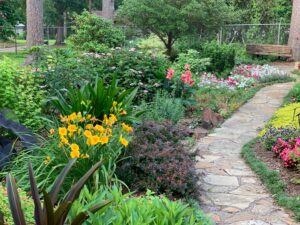 We have been getting a lot of questions lately from homeowners wanting to replace their lawns with more water wise, and beneficial plants. This is a fantastic trend, seeing as how water is a very limited resource, and that lawns do not have much to offer to our native pollinators.
We have been getting a lot of questions lately from homeowners wanting to replace their lawns with more water wise, and beneficial plants. This is a fantastic trend, seeing as how water is a very limited resource, and that lawns do not have much to offer to our native pollinators.
If lawn replacement has been on your mind, here are some things to think about. The first thing to consider is, how much of your lawn are you actually using? Looking into lawn replacement does not have to mean getting rid of all lawn but reducing your lawn to the areas that are being used. Children use lawns to run and play, as do pets. Keeping lawn areas that are being used is great, but if you have lawn areas that are not being used, you may want to consider replacing them with something else.
Once you identify areas of lawn that you would like to replace, the next step is getting rid of the lawn. There are a few options. One option is to cover the areas of undesired lawn with a thick layer of newspaper or cardboard for about 2 months. This will suffocate the lawn and kill it leaving you with a blank slate. You can also till the area several times over a period. A quicker, albeit less environmentally friendly way of getting rid of the lawn would be to use a nonselective herbicide. If you go this route, be sure to read the label and follow all instructions. Never apply herbicides to flowering plants being visited by pollinators (such as dandelions) and avoid spraying when it is windy or over 80° F to avoid drift, which could harm desirable plants.
Once the lawn is gone, I would suggest looking into getting a soil test. If you are going to put in the effort to plant something new and beautiful, you may as well see what is going on in your soil and what you can do to make it optimal for your new plants. If you don’t want to get your soil tested, you can simply add some plant-based compost and mix it in with the native soil. This will help with soil texture, which will improve drainage and moisture retention.
Now for the exciting part, what should you plant?? If you want to keep the same type of look as your lawn, you can go for a groundcover plant. Creeping thyme, Veronica, creeping jenny, sedum, or oregano are some low growing options that you can investigate. A whole list of water wise groundcovers can be found here: https://extension.colostate.edu/topic-areas/yard-garden/xeriscaping-ground-cover-plants-7-230/.
You can also plot out some garden beds that have annual and perennial flowers. CSU Extension has many plant lists if you need some inspiration on what to plant. You can start browsing here: https://cmg.extension.colostate.edu/gardening-resources/online-garden-publications/flowering-herbaceous-plants-flowers-ground-covers-and-ornamental-grasses/.
The Master Gardener help line is open Mondays, Wednesdays, and Fridays from 9 am to 11 am and 2 pm to 4 pm if you would like to seek further advice on replacing your lawn from a trained volunteer.


